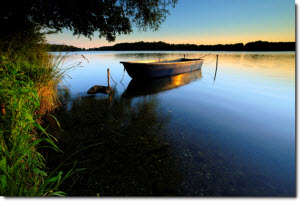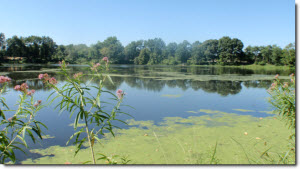Where This Occurs: Lakes and Rivers

Nutrient pollution builds up in our nation's lakes, ponds, and streams. EPA's 2010 National Lakes Assessment found that almost 20 percent of the 50,000 lakes surveyed had been impacted by nitrogen and phosphorus pollution. The report also showed that poor lake conditions related to nitrogen or phosphorus pollution doubled the likelihood of poor ecosystem health.
When river or stream currents are slow, or when waters are stagnant, nutrients, sediment, and particles accumulate, increasing the chances of harmful pollution and algal growth. In EPA's 2006 Wadeable Stream Assessment, 30 percent of streams across the country had high levels of nitrogen or phosphorus. Lakes and rivers are common sources for drinking water supplies. Both algae and high nitrate levels cause problems in sources of drinking water. Nationwide, violations of the nitrate limit in drinking water doubled over a 10-year period.
Case Study: Lake Oneida, New York: Agricultural Environmental Management Projects Reduce Excess Nutrients

Algal blooms and rooted vegetation impaired recreational uses of New York's Oneida Lake, causing New York to add the lake to its Clean Water Act impaired waters list in 1998. Excess nutrients, specifically phosphorus, from agricultural, urban and suburban runoff contributed to the growth of algal blooms in the lake. Implementing best management practices such as barnyard runoff management systems, manure storage systems, and nutrient and sediment control systems successfully reduced phosphorus loads to Oneida Lake. The New York State Department of Environmental Conservation delisted Oneida Lake because data showed steady declines in phosphorus levels and indicated that the lake supports aquatic life and recreation.
Case Study: Lower Piper Creek and Upper and Lower Goat Creek, Montana
Goat Creek is a tributary to Swan River, which is situated in a heavily forested watershed in northwest Montana. Construction of forest roads and timber harvesting led to sediment and nutrient pollution in Goat Creek, which made the creek unable to adequately support aquatic life. Private development also contributed to this problem due to the removal of wooded areas, the introduction of septic systems and road construction.
The Montana Department of Environmental Quality, a group of partners from the timber industry and federal agencies developed Total Maximum Daily Loads for waters in the Swan Lake Watershed to reduce sediment and nitrogen and phosphorus pollution. Over the past 20 years, efforts have included the implementation of forestry best management practices-establishing drainage catchments along forest roads to intercept sediment in runoff, upgrading old roads, and implementing an erosion control standard by the end of 2015. As a result of these actions, by 2006, Upper Goat Creek was no longer considered impaired due to nutrients.
